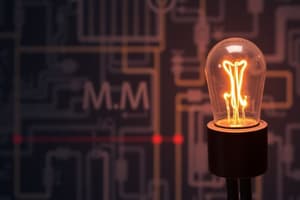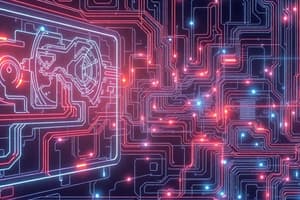Podcast
Questions and Answers
What is the reason for using circuit control devices?
What is the reason for using circuit control devices?
- To control the flow of electricity in a circuit (correct)
- To measure the voltage and current in the circuit
- To generate electrical power
- To provide a visual indication of the circuit status
Which of the following is a general type of circuit control device?
Which of the following is a general type of circuit control device?
- Switch (correct)
- Resistor
- Capacitor
- Voltmeter
What is the difference between a manual and an automatic switch?
What is the difference between a manual and an automatic switch?
- Manual switches have higher voltage ratings than automatic switches
- Automatic switches are used in residential buildings, while manual switches are used in commercial buildings
- Automatic switches are operated by hand, while manual switches operate automatically
- Manual switches require human intervention to operate, while automatic switches operate without human intervention (correct)
What is the reason for using multicontact switches?
What is the reason for using multicontact switches?
How many possible positions does a single-pole, double-throw switch have?
How many possible positions does a single-pole, double-throw switch have?
What is the common name for an accurate snap-acting switch?
What is the common name for an accurate snap-acting switch?
What is the main purpose of circuit control devices?
What is the main purpose of circuit control devices?
What was the early means for turning power on and off as practical uses for electricity were found?
What was the early means for turning power on and off as practical uses for electricity were found?
What was the early experimenters' method for controlling power to their experiments?
What was the early experimenters' method for controlling power to their experiments?
What was used in the late 1700s and perfected by Morse in the 1830s to open and close the signal circuit?
What was used in the late 1700s and perfected by Morse in the 1830s to open and close the signal circuit?
What was the early form of circuit control devices known as?
What was the early form of circuit control devices known as?
What is the main function of modern circuit control devices?
What is the main function of modern circuit control devices?
What was the beginning of circuit control devices?
What was the beginning of circuit control devices?
What is the simplest form of circuit control?
What is the simplest form of circuit control?
How did early experimenters control power to their experiments?
How did early experimenters control power to their experiments?
Why was a convenient means for turning power on and off needed as practical uses for electricity were found?
Why was a convenient means for turning power on and off needed as practical uses for electricity were found?
What is the difference between a single-pole, double-throw switch and a double-pole, double-throw switch?
What is the difference between a single-pole, double-throw switch and a double-pole, double-throw switch?
Which of the following correctly describes a momentary switch?
Which of the following correctly describes a momentary switch?
What is the main function of a solenoid in a circuit?
What is the main function of a solenoid in a circuit?
What is the reason for using multicontact switches?
What is the reason for using multicontact switches?
What does a rocker switch refer to in the context of circuit control devices?
What does a rocker switch refer to in the context of circuit control devices?
What is the purpose of a relay in a circuit?
What is the purpose of a relay in a circuit?
What is the main purpose of circuit control devices?
What is the main purpose of circuit control devices?
What was the early means for turning power on and off as practical uses for electricity were found?
What was the early means for turning power on and off as practical uses for electricity were found?
What was the beginning of circuit control devices?
What was the beginning of circuit control devices?
Why was a convenient means for turning power on and off needed as practical uses for electricity were found?
Why was a convenient means for turning power on and off needed as practical uses for electricity were found?
What was used in the late 1700s and perfected by Morse in the 1830s to open and close the signal circuit?
What was used in the late 1700s and perfected by Morse in the 1830s to open and close the signal circuit?
What is the difference between a manual and an automatic switch?
What is the difference between a manual and an automatic switch?
What is the common name for an accurate snap-acting switch?
What is the common name for an accurate snap-acting switch?
What is the simplest form of circuit control?
What is the simplest form of circuit control?
How many possible positions does a single-pole, double-throw switch have?
How many possible positions does a single-pole, double-throw switch have?
Flashcards are hidden until you start studying
Study Notes
- Circuit control devices are used in various fields where electrical or electronic circuits are present, including submarines, computers, aircraft, televisions, medical instruments, and more.
- Electricity was discovered before recorded history, but practical uses were not recognized until the late 18th century.
- Early methods of controlling electricity included disconnecting wires from batteries or using clutches between generators and steam engines.
- Telegraph systems used a mechanically operated contact lever for opening and closing circuits in the late 1700s and early 1800s.
- Early power switches were simple hinged beams arranged to open or close circuits.
- Modern circuit control devices can change resistance from a few milliohms to over 100,000 megaohms in milliseconds.
- Some devices only require a movement of.001 inch to open or close.
- Circuit control is needed to turn power on and off or open and close circuits.
- If a circuit develops problems that could damage equipment or endanger personnel, it should be possible to control the power.
- Circuit control devices include switches, solenoids, and relays.
- Switches change the flow of electricity when they are closed or opened. They have schematic symbols, different types (manual, automatic, multicontact, rocker, etc.), and various positions (single-pole, double-throw, etc.).
- Solenoids are electrically operated valves that control the flow of fluids. They have an operating principle and can be checked for proper operation through various methods.
- Relays are switches that use an electromagnetic force to open or close circuits. They come in different types (contact, mercury-wetted, reed, etc.) and can be checked for proper operation and serviced accordingly.
- Circuit control devices have current and voltage ratings, which determine the maximum amount of electricity they can handle.
- Two types of meters can be used to check switches: digital multimeters and clamp meters.
- Proper substitute switches can be selected from a list based on specifications.
- Preventive maintenance of switches includes checking conditions such as contacts, actuators, and insulation resistance.
- Solenoids operate based on the principle of a magnetic field, while relays use electromagnetic force to change the state of a circuit.
- Solenoids and relays can be checked for proper operation through methods such as visual inspection, electrical testing, or observing the effect on the controlled device.
- Relays can be serviced by cleaning, adjusting, or replacing parts as needed.
Studying That Suits You
Use AI to generate personalized quizzes and flashcards to suit your learning preferences.




